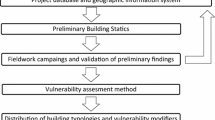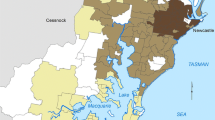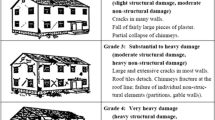Abstract
This paper is concerned with an investigation of the damage to residential buildings in two areas within Gilan and Zanjan provinces, Iran, caused by the Manjil-Rudbar earthquake of 20 June 1990. A statistical correlation between the observed ground motion and the damage to the residential buildings is derived for overall damaged buildings and expressed as the vulnerability function. The loss function is calculated by combining the seismic hazard with the vulnerability function.
The study of vulnerability and annual seismic hazard shows that the specific annual risk for the range of motion of 0.18 to 0.5 g is equal to 0.02. This indicates that the specific risk for semi-engineered residential buildings with a lifetime of 20 years is about 33%. This study also shows that in large cities, such as Tehran, located in seismic areas, the extent of damage according to the vulnerability function will be 45 and 70% for expected maximum accelerations of 0.3 and 0.4 g, respectively.
Similar content being viewed by others
References
Algermissen, S. T. and Steinbrugge, K. V.: 1984, Seismic hazard and risk assessment; Some case
Algermissen, S. T.et al.: 1973,A Study of Earthquake Losses in Los Angeles, FDAA, Washington, D.C., U.S.A.
Applied Technology Council (ATC): 1985.Earthquake Evaluation Data for California (ATC-13), Redwood City, Ca, U.S.A.
Berberian, M. and Qurashi, M.: 1991, The June 20, 1990 Rudbar-Tarum (NW Persia) catastrophic earthquake; A preliminary field reconnaissance report,Proc. 1st Int. Conf. Seis. and Earthquake Engng., Vol. 3, Iran.
BHRC: 1991,Accelerograms of the Manjil, Iran Earthquake of 20 June 1990, Qazvin, Abhar and Roudsar, Vols. 1, 2, Building and Housing Research Center, Tehran, Iran.
Bozognia, Y. and Mohajer-Ashjai, A.: 1982, Seismic risk investigation of major cities of Iran,J. Earth Space Phys. 11, 15–38.
Cornell, C. A., 1968, Engineering seismic risk analysis,Bull. Seism. Soc. Amer. 58, 1583–1606.
Cornell, C. A.: 1971, Probabilistic analysis of damage to structures under seismic load,Dynamic Waves in Civil Engineering, Wiley, London.
Cornell C. A. and Merz H. A.: 1973, Seismic risk analysis based on a quadratic magnitude-frequency law,Bull. Seism. Soc. Amer. 63, 1999–2006.
Hopper, M. G.et al. 1975, A study of earthquake losses in Puget Sound, USGS Report, Washington, D.C. Open-file Report 75–375,USGS.
IIEES: 1991, Rudbar-Manjil earthquake, June 20, 1990, Report 70-1, Int. Inst. of Earthquake engng, and Seismol. Iran.
Kircher, C. and McCann, M.: 1983, Development of fragility curves for estimation of earthquake-induced damage, USGS Report-437, Washington D.c., U.S.A.
Lomnitz, C.: 1971,Global Tectonics and Earthquake Risk, Elsevier, Amsterdam.
McGuire, R. K.: 1977, Fortran computer program for seismic risk analysis, US Geological Survey, Open file Report 7667.
Niazi, M. and Bozorgnia, Y.: 1991, Comparison of the ground-motion attenuation during the 1990 Manjil, Iran, and the 1989 Loma Prieta, USA, earthquakes.Proc. 1st int. Conf. Seis. and Earthquake Engng (SEE-1), pp. 289–298.
Reitherman, R.: 1985, A review of earthquake damage estimation methods,Earthquake Spectra 1, No. 4.
Scawthron C.et al.: 1981, Seismic damage estimation for low and mid-rise buildings in Japan,Earthq. Eng. & Struc. Dyn. 9, 93–115.
Scholl, R. E.: 1974, Statistical analysis of low-rise buildings damage caused by San Fernando earthquake,Bull. Seism. Soc. Amer. 64, 1–23.
Tavakoli, B.et al.: 1991 A statistical analysis of the damage by Manjil earthquake June 20, 1990, Iran,Proc. 6th Int. Seminar Earthquake Prognostics, Berlin.
UNDRO: 1990, Mission report and technical review of the impact of the earthquake of 21 June 1990 in the provinces of Gilan and Zanjan, UNDRO Report GE.90-03511, United Nations.
Wiggins, J. H.: 1981, Earthquake hazard and risk mitigation, J. H. Wiggins Company, Report. No. 80-1371-1.
Author information
Authors and Affiliations
Rights and permissions
About this article
Cite this article
Tavakoli, B., Favakoli, A. Estimating the vulnerability and loss functions of residential buildings. Nat Hazards 7, 155–171 (1993). https://doi.org/10.1007/BF00680428
Received:
Issue Date:
DOI: https://doi.org/10.1007/BF00680428




